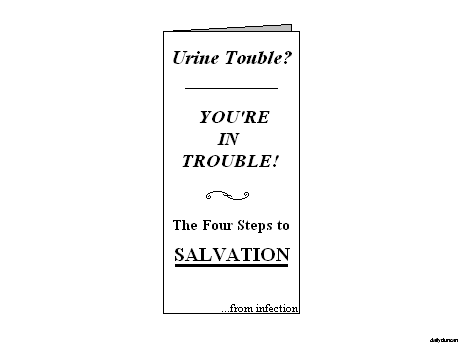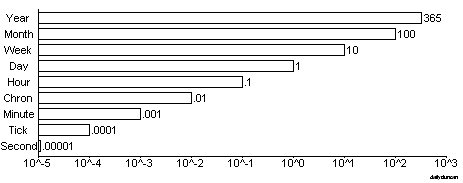Although we’ve made significant progress unraveling the mysteries of time in parts I and II, there are a few steps yet untaken. Leap years, the varying mass and rotation of the Earth, daylight savings time and time zones all serve to disrupt the metric order and should either be corrected or eliminated.
First let’s talk about the length of a year. It actually takes around 365.242375 days for the Earth to complete one revolution around the Sun, which means that we need to somehow account for the extra .242375 days left over at the end of each year. Right now, we do this by adding an extra day to the calendar. These 366-day years are called leap years. Every four years we have a leap year, unless the year is divisible by 100, in which case we skip the extra day. However, if the year is divisible by 400, then we ignore the previous rule and add the 366th day. This system of leap years only accounts for an extra .2425 days per year, which means that every 8,000 years we need to skip a leap year. And as we already know, there are certainly more decimal places requiring us to make even more refined adjustments.
Part of the purpose for creating a metric time system is consistency, so having our years fluctuate in length is not something we can accept. There have been several proposed solutions to this issue, but the simplest one is to extend the length of each day. In order to make up the .242375 days, we must make each day .00066404 days longer (about 66.4 metric seconds). However, instead of making each day 100,066.404 metric seconds long, we can simply extend the duration of a metric second by.066404%, which would mean that the time between each tick on the metric clock is now .86057 standard seconds. But even if we make all these adjustments, there is yes another problem: the mass and rotation of the Earth is not constant.
Tidal friction and shifts in the Earth’s core shorten or lengthen the day. A major earthquake in the Indian Ocean in 2004 is said to have shortened the day by 3 microseconds or about 30 metric nanodays. The mass of our planet is also changing, with thousands of kilograms of meteorites and space dust falling to Earth each year, and a massive amount of hydrogen, helium and astronauts constantly escaping our atmosphere. Changes in mass effect the gravitational pull of the Earth on the Moon, and of the Sun on the Earth. Although these changes are slight, they will eventually make a difference. Given the current rate of change in the Earth’s rotation, an increase of .000017 seconds per day each year, in 1 billion years our days will be 28.72 hours long, and our years will be 305 days. Applying the solution we reached above, we will slowly increase the duration of our second to keep our units in base 10, and in the year 957,590,248 AD, 1 metric second will be exactly 1 standard second in duration.
Now let’s talk about daylight savings time. It’s dumb and should be destroyed.
Another obstacle in the implementation of a consistent metric time system is time zones. Time zones exist because each point on the globe has its own solar time – the time of day according to the position of the Sun in the sky – and we all want to understand time in the same way. After all, how strange would it be to eat lunch at midnight or watch sunset at 6:00 AM? And regardless of whether we recognize it, the various populations of the world are existing at different points in their day.
But time zones come at a price. They make long-distance travel and communication more complicated, since we’re always doing math to determine the difference in time between ourselves and the our target. Although this is useful in ensuring that we don’t wake our relatives by calling them at night, the idea that the whole world is existing at different times is not accurate. We may be at different points relative to the Sun, but the events in Beijing are not happening 12 hours before the events in New York. If someone takes a plane from Beijing to New York, they will land at about the same time they left. No, they didn’t travel back in time by merely flying around the Earth, since only Superman can do that.
So what’s the solution to the problem of time zones? If we pretend that they don’t exist, we’re ignoring the experiential component of time. But if we incorporate them, then we’re creating an inconsistent time system. For an answer, let’s take a look at how we deal with seasons.
Australians experience their summer from December to February, months that much of the world would associate with winter. Because the Earth is tilted on its axis, those south of the equator experience the seasons differently than those who dwell north of it. But we don’t change the names of months or seasons depending on our location, so why would we change the time? As with seasons, let’s allow each person create their own associations with time.
So if there’s no time zones, then how do we know the time in relation to the Sun in other parts other world? Instead of using inaccurate zones that are heavily influenced by geological and geographical borders, we could simply add a numerical affix to indicate the local solar time, indicating the precise solar time based on longitude. Here’s an example of the time in New York City shown in both standard time and metric time with a local solar time affix:
January 23, 6:27 AM Eastern Time
22.268 (-2.056)
New York City resides at approximately 74 degrees latitude, meaning that it’s about 20.56% of the Earth’s surface away from the prime meridian. This puts New York City’s time at minus 4 hours and 56 minutes standard time, or -2.056 metric hours.
But there’s a problem. Deciding the which part of the globe experiences morning at metric time 0 is completely arbitrary, as there isn’t actually an east or west side of the Earth. In other words, the Earth’s rotation never stops and therefore has no beginning or end. This also brings up the issue of the new year as well, since there isn’t a moment of origin to the Earth’s revolutions. So how do we decide when our days and years begin? And while we’re at it, when was year 1?
The answer, unfortunately, is that there is no criteria we can use to determine the true time to start our days and years. History, however, could obviously start at year 1 if we knew when that was. But since our understanding of the age of the universe is subject to prevailing interpretation and limited data. And since we cannot know this for certain, we must choose a point of reference – a position on the globe, a time in history and a place in Earth’s orbit from which we may measure. Since reform is difficult to implement, we might as well borrow the current points of reference: the Greenwich Meridian, January 1 and the birth of Christ (at year 0).
Of course, assigning a year in history to 0 means that time before that point is negative. But unless we know the precise moment that our universe came into existence, we must compromise.
Now that we’ve got everything wrapped up, let’s go back to those problems in part I and answer the last question using both standard and metric time. The question was, “how many seconds are between 5:19:31 PM on September 5, 231 BC in Rome and 3:26:04 AM on August 22, 1746 in Central China?”
First, in standard time:
- 5 hours + 12 hours = 17 hours
- 17 hours * 60 minutes * 60 minutes = 61,200 seconds
- 61,200 seconds + 19 minutes * 60 seconds + 31 seconds = 62,371 seconds
- 30 days – 5 days = 25 days
- 25 days + 31 days + 30 days + 31 days + 31 days + 28 days + 31 days + 30 days + 31 days + 30 days + 31 days + 22 days = 351 days
- 1746 years + 231 years = 1977 years
- 365.2425 days * 1977 years + 351 days = 722,435.4225 days
- 3 hours * 60 minutes * 60 seconds = 10,800 seconds
- 10,800 seconds + 26 minutes * 60 seconds + 4 seconds = 12,364 seconds
- (8 – 1) hours * 60 minutes * 60 minutes = 25,200 seconds
- 722,436.4225 days * 24 hours * 60 minutes * 60 seconds + 32,371 seconds + 12,364 seconds + 25,200 = 62,418,520,439 seconds
And now in metric time:
- 10 hours – 7.21667 hours * 100 minutes * 100 seconds = 27833.33 seconds
- 365 days – 248 days + 234 = 117 days
- 1746 years + 231 years + 1 year = 1978 years
- 1978 years * 365 days + 351 days = 722,321 days
- 1.431 hours * 100 minutes * 100 seconds = 14,310 seconds
- 722,321 days * 10 hours * 100 minutes * 100 seconds + 27833.33 seconds + 14,310 seconds = 72,232,142,143.33 seconds
It’s easy to see that the metric system allows for much simpler calculations, and would be even more simple if the problem was written in metric time. Click here to see the answers for all of the problems.
So there’s no more Mondays, no more March, no more AM and no more time zones. Time starts at 0 and a metric second is 10 microdays, which is about .86 standard seconds long. This is the future of time measurement, and if you don’t like shorter seconds, freeze yourself and ask to be reanimated in 957,590,248.



